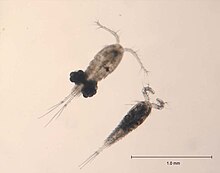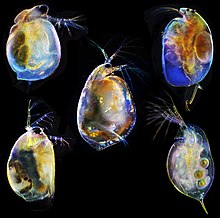by GR HEALY · 1970 · Cited by 22 — infected with. 0. felineus. In some regions of central. Siberia, large numbers of humans have been reported to be infected. In other regions of Russia
Crustaceans (Crustacea /krʌˈsteɪʃə/) form a large, diverse arthropod taxon which includes such animals as crabs, lobsters, crayfish, shrimps, prawns, krill, woodlice, and barnacles.[1] The crustacean group can be treated as a subphylum under the clade Mandibulata; because of recent molecular studies it is now well accepted that the crustacean group is paraphyletic, and comprises all animals in the clade Pancrustaceaother than hexapods.[2] Some crustaceans (Remipedia, Cephalocarida, Malacostraca) are more closely related to insects and the other hexapods than they are to certain other crustaceans.[3]
The 67,000 described species range in size from Stygotantulus stocki at 0.1 mm (0.004 in), to the Japanese spider crab with a leg span of up to 3.8 m (12.5 ft) and a mass of 20 kg (44 lb).
https://en.wikipedia.org/wiki/Crustacean
| Ostracod | |
|---|---|
 | |
| Scientific classification | |
| Kingdom: | Animalia |
| Phylum: | Arthropoda |
| Subphylum: | Crustacea |
| Superclass: | Oligostraca |
| Class: | Ostracoda Latreille, 1802 |
| Subclasses and orders | |
| |
Ostracods, or ostracodes, are a class of the Crustacea (class Ostracoda), sometimes known as seed shrimp. Some 70,000 species (only 13,000 of which are extant) have been identified,[1] grouped into several orders. They are small crustaceans, typically around 1 mm (0.039 in) in size, but varying from 0.2 to 30 mm (0.008 to 1.181 in) in the case of Gigantocypris. Their bodies are flattened from side to side and protected by a bivalve-like, chitinousor calcareous valve or "shell". The hinge of the two valves is in the upper (dorsal) region of the body. Ostracods are grouped together based on gross morphology. While early work indicated the group may not be monophyletic;[2] and early molecular phylogeny was ambiguous on this front,[3] recent combined analyses of molecular and morphological data found support for monophyly in analyses with broadest taxon sampling.[4]
Ecologically, marine ostracods can be part of the zooplankton or (most commonly) are part of the benthos, living on or inside the upper layer of the sea floor. Many ostracods, especially the Podocopida, are also found in fresh water, and terrestrial species of Mesocypris are known from humid forest soils of South Africa, Australia and New Zealand.[5] They have a wide range of diets, and the group includes carnivores, herbivores, scavengers and filter feeders.
As of 2008, around 2000 species and 200 genera of nonmarine ostracods are found.[6] However, a large portion of diversity is still undescribed, indicated by undocumented diversity hotspots of temporary habitats in Africa and Australia.[7] Of the known specific and generic diversity of nonmarine ostracods, half (1000 species, 100 genera) belongs to one family (of 13 families), Cyprididae.[7] Many Cyprididae occur in temporary water bodies and have drought-resistant eggs, mixed/parthenogenetic reproduction, and the ability to swim. These biological attributes preadapt them to form successful radiations in these habitats.[8]
https://en.wikipedia.org/wiki/Ostracod
Maxillopoda is a diverse class of crustaceans including barnacles, copepods and a number of related animals. It does not appear to be a monophyletic group, and no single character unites all the members.[2]
| Maxillopoda | |
|---|---|
 | |
| Cyclops (Copepoda: Cyclopoida) | |
| Scientific classification | |
| Kingdom: | Animalia |
| Phylum: | Arthropoda |
| Subphylum: | Crustacea |
| Class: | Maxillopoda Dahl, 1956 [1] |
| Subclasses | |
https://en.wikipedia.org/wiki/Maxillopoda
Branchiopoda is a class of crustaceans. It comprises fairy shrimp, clam shrimp, Cladocera, Notostraca and the Devonian Lepidocaris. They are mostly small, freshwater animals that feed on plankton and detritus.
| Branchiopoda | |
|---|---|
 | |
| Triops (Notostraca: Triopsidae) left: dorsal view; right: ventral view | |
| Scientific classification | |
| Kingdom: | Animalia |
| Phylum: | Arthropoda |
| Subphylum: | Crustacea |
| Class: | Branchiopoda Latreille, 1817 |
| Orders | |
| |

https://en.wikipedia.org/wiki/Branchiopoda
| Cladocera | |
|---|---|
 | |
| Scientific classification | |
| Kingdom: | |
| Phylum: | |
| Subphylum: | |
| Class: | |
| Subclass: | |
| Superorder: | Cladocera Latreille, 1829 |
| Suborders | |
| |
| Synonyms | |
Eucladocera (no evidence for grouping together all other cladocerans as the sister taxon to the monotypic Haplopoda (Leptodora)) | |
The Cladocera, commonly known as water fleas are an order of small crustaceans that feed on microscopic chunks of organic matter (excluding some predatory forms). [1]
Over 650 species have been recognised so far, with many more undescribed.[2][3][4][5] The oldest fossils of cladocerans date to the Jurassic, though their modern morphology suggests that they originated substantially earlier, during the Paleozoic. Some have also adapted to a life in the ocean, the only members of Branchiopoda to do so, even if several anostracans live in hypersaline lakes.[6] Most are 0.2–6.0 mm (0.01–0.24 in) long, with a down-turned head with a single median compound eye, and a carapace covering the apparently unsegmented thorax and abdomen. Most species show cyclical parthenogenesis, where asexual reproduction is occasionally supplemented by sexual reproduction, which produces resting eggs that allow the species to survive harsh conditions and disperse to distant habitats.
https://en.wikipedia.org/wiki/Cladocera
above. the pussycat dolls - dont cha
No comments:
Post a Comment